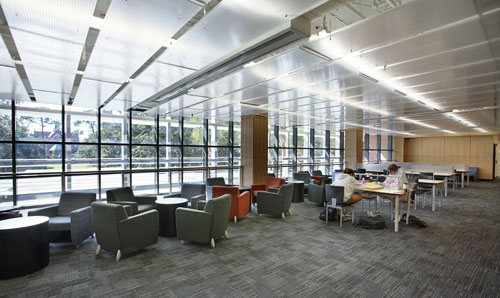Translucent Cellular Polycarbonate Delivers Design Versatility
Polycarbonate Properties & Performance
Because of their versatile properties, which position them between commodity plastics and engineering plastics, the second largest use of polycarbonates is for construction material (the first is for electronics components). A testament to the strength of polycarbonate is the fact that airplane windows are made of it.
Clarity/Light Transmission/Daylighting
Clear PCSS allows more light transmission than fiberglass reinforced panels (FRP). Soft, even daylighting can be achieved through opal or frosted polycarbonates. Studies have found that access to daylight enhances well being and quality of life. Daylighting is also linked to improved learning, increased retail sales and office worker productivity.1
Students with the most daylighting in their classrooms progress faster on math (20 percent) and reading tests (26 percent) than those with the least light in their classrooms. Another study found that diffused daylighting increased retail sales—up to 40 percent for one major retailer. Further, other research reports that call center workers handled calls 6 to 12 percent faster, while office workers tested 10 to 25 percent better when compared with those working in less natural light. Glare, from any source, potentially decreased office worker performance by 15 percent to 21 percent.
Impact Resistance
PCSS products offer high impact resistance and protection against storm damage and vandalism. Some polycarbonate glazed systems have met the product testing requirements of Florida, Miami-Dade and Texas Building Codes. However, many of those systems require close spacing of framing or other reinforcement, which may raise aesthetic issues.
In some applications PCSS has been demonstrated to be practically unbreakable. Polycarbonate is 250 times more impact resistant than an equivalent thickness of annealed glass and 30 times more than that of non-modified acrylic.
A PCSS surface is softer than that of glass and its structure is more crushable than glass. To address this, some manufacturers incorporate special framing designs to restrict the pressure of the gasketing against the polycarbonate. This is called “controlled gasket pressure.”
Energy Savings
PCSS offers significant benefits in thermal insulation due to the many airspaces between the inner and outer panel faces. Because of the variety of available profiles and resins, it can deliver high levels of light transmission while also maintaining high R-values (thermal resistance.)
One inch of cellular polycarbonate, compared with one inch of insulated glass, has an R-value of 3.84 compared with 2.08 for the glass. Their U-values (rate of heat loss which is the inverse of the R-value) are 0.26 and 0.48 respectively.
Significantly increased thermal performance may be achieved by combining polycarbonates with translucent aerogel, a substance derived from a gel in which the liquid component of the gel has been replaced with a gas.
Aerogel manufacturers claim:
* High light transmission
* Non-combustible
* Totally recyclable
* Non-toxic
* Silica gel–97% air
* Hydrophobic
However, it should be noted that aerogel fillings in cellular polycarbonate are a relatively new item and long-term field performance has yet to be established.
Resistance to Flame/Heat and Smoke
Smoke density, flame spread and self-combustion measurements are all important factors when describing the safety performance of all plastics. When considering these factors, PCSS offers much better results than either FRP or acrylic.
PCSS in various profiles are typically available as Class A-, B- or C-rated materials for flame spread and smoke generation (see sidebar Standards and Definitions.) Properties of PCSS include:
* Self-ignition temperature >842° F (450° C) {Note: IBC 2606.7 requires plastic materials to have a self ignition temperature of 650° F (343° C ) or greater.} * Softening temperature point: 320° F (160° C) (this meets International Code Council acceptance criteria) * Decomposition occurs at approximately 715° F (380° C)
UV Resistance and Yellowing
Sheet degradation is measured using a yellowness index, ∆YI, calculated from spectrophotometric data that describes the change in color of a test sample from clear or white toward yellow. In addition to change in color, ∆YI correlates with a proportionate amount of loss of the sheet's ability to transmit light. A ∆YI over 5 will also have a reduced impact resistance. Different warranties for polycarbonate products reflect the effectiveness of UV protection. When evaluating polycarbonate sheet materials for use as glazing, design professionals should compare warranties to see which offers the best protection against yellowing, impact resistance and light transmission degradation. Most current architectural panels qualify for a ∆YI of 2 or less even after the equivalent of 10 years in a south-facing application.
 |
Examples of multiwall polycarbonate yellowing indices (ΔYI) Image courtesy of EXTECH/Exterior Technologies, Inc |
Cellular Polycarbonate Suspended Ceiling: |
||
For the ceilings of the 117,000-sq-ft renovation of the University of Florida Library West, Ross Barney Architects of Chicago, Ill., and partners Long & Associates Architects/ Engineers, Inc., Tampa, Fla., chose cellular polycarbonate panels. The standing seam panels were suspended via small cables and clips at each corner. The panels were placed with a nominal 3-in. space between them so that maintenance personnel could easily unhook them or simply push them to one side to reach above and change light bulbs. “It was a very simple solution,” says principal-in-charge Michael A. Ross, AIA, LEED AP. The separations also aided the acoustic value of the ceiling. In some areas, the architect used the linear configuration of the panels to provide directional cues to different parts of the library. |










